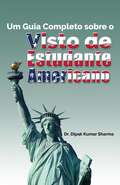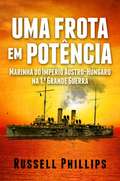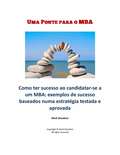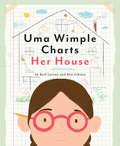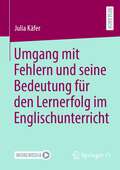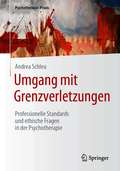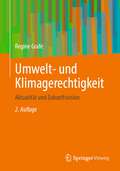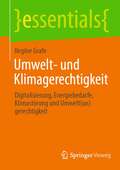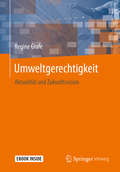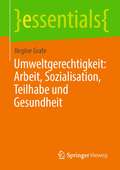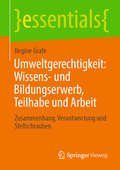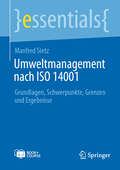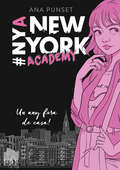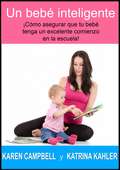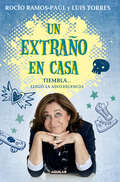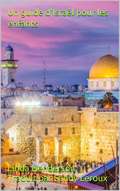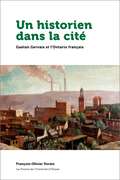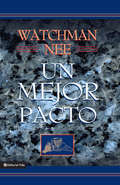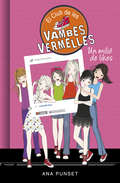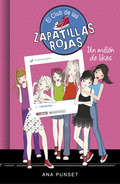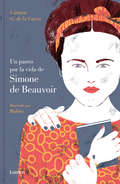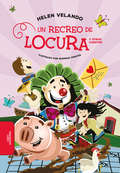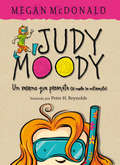- Table View
- List View
Um Guia Completo sobre o Visto de Estudante Americano
by Dr Dipak Kumar Sharma RonaldoEste livro é praticamente a “mãe dos livros” com referência ao Visto de Estudante Americano. Faça a diferença entre estar lá e ter sucesso lá. Este livro é igualmente útil para estudantes internacionais que pretendem ira para os Estados Unidos e, também para aqueles que já são estudantes internacionais nos Estados Unidos. Um livro fácil de ler que mostra o passo a passo com perguntas e respostas em cada seção. Centenas de cenários da vida real abordados e explicados. Economize tempo e dinheiro, sem a necessidade de pagar advogados de imigração ou agentes de vistos privados. Não há necessidade de desperdiçar seu tempo pesquisando toneladas de material on-line, lendo blogs ou ouvindo boatos. Você terá todas as informações que provavelmente precisará saber (e mais), sobre seu visto de estudante em um único lugar.
Uma Frota Em Potência: Marinha Do Império Austro-Húngaro Na 1.ª Grande Guerra
by Russell Phillips André LeiteIlustrado com cerca de trinta fotografias e desenhos, este livro oferece uma abrangente e detalhada descrição dos navios que compunham a frota do Império Austro-Húngaro, das suas operações e dos seus problemas específicos, desde duelos parlamentares a navios construídos pela Hungria, país desprovido de costa. A Kaiserliche und Königliche Kriegsmarine -- Marinha Austro-Húngara -- Descrita desde o início da 1.ª Guerra Mundial quando o Arquiduque Franz Ferdinand e a sua esposa Sophie repousaram em câmara ardente no navio almirante, até ao final do conflito quando a própria marinha se dissolvia tal qual o seu império. Durante a Guerra, esta pequena mas poderosa "frota em potência" forçou os Aliados a manter um bloqueio nos Estreitos de Otranto enquanto submarinos Alemães e Austro-Húngaros semeavam o caos no Mediterrâneo apesar dos seus grandes navios quase nunca deixarem os seus portos de abrigo.
Uma Ponte Para O Mba
by Mark Dresdner Patricia FrancoO objetivo deste livro é guiar os candidatos aos curso de MBA nas mais renomadas escolas de Administração do mundo a prepararem suas candidaturas de uma forma correta e eficaz.Um dos maiores desafios dos candidatos está em como preencher o caderno de inscrição e escrever os Essays. Este é o ponto chave deste guia simples, didático e eficaz.A ponte para o MBA, construída por Mark Dresdner, busca levar o candidato a fazer uma análise de sua carreira profissional, sua formação acadêmica e sua vida pessoal de modo que esteja apto a escrever essays sinceros e que reflitam suas maiores realizações e conquistas.Para os leitores brasileiros, é de especial valor a inclusão dos essays originais em inglês, além da tradução, pois possibilita estudar o vocabulário e a construção do texto em língua inglesa possibilitando uma compreensão mais completa do tipo de texto que as comissões de admissão esperam receber.
Uma Wimple Charts Her House
by Reif Larsen Ben GibsonHip, funny, unique--and a perfect curriculum tie-in--here's a picture book with mega kid-appeal about the challenges a student faces when she is given an assignment to make a chart of her own home!Uma's been making charts since she was a little kid. But when her teacher gives the class Uma's dream assignment--to make a chart of their own homes--she is thrown for a loop. Oh, the possibilities! Oh, the pressure! What makes a house housey? she wonders. In order to figure it out, she asks each member of her family--Mom, Dad, and brothers Rex, Bram, and Lukey. But it's not until she has a meltdown and Lukey comforts her that Uma figures out the secret to her chart--and her family. It's the love that is shared inside a house's walls.Told in first-person and featuring engaging graphic artwork, this fun and lively picture book--perfect for classroom use--is a reminder that someone's true home is not a place, but rather the people with whom you surround yourself.
Umgang mit Fehlern und seine Bedeutung für den Lernerfolg im Englischunterricht
by Julia KäferDie Arbeit widmet sich dem Umgang mit Fehlern im Unterricht und untersucht empirisch seine Bedeutung für den Lernerfolg von Schülerinnen und Schülern im Fach Englisch der Sekundarstufe I. Hierzu wird ein multiperspektivischer Untersuchungsansatz verfolgt: Neben der Perspektive der Schülerinnen und Schüler werden auch Einschätzungen externer Beobachterinnen und Beobachter zum Umgang mit Fehlern im Unterricht herangezogen. Unter Berücksichtigung des aktuellen theoretischen und methodischen Forschungsstandes wird damit einerseits der Zusammenhang zwischen der Wahrnehmung von Schülerinnen und Schülern zum Umgang mit Fehlern im Unterricht und ihrer Leistung wie auch ihrer Lernmotivation untersucht und gleichzeitig geprüft, inwieweit die Schülerwahrnehmung durch individuelle Schülermerkmale sowie durch Merkmale des Lernkontexts beeinflusst wird. Andererseits wird in dieser Arbeit das Potenzial der in der empirischen Unterrichtsforschung bislang wenig eingesetzten Thin-Slices-Methode exploriert und geprüft, inwieweit heuristische Urteile externer Beobachterinnen und Beobachter geeignet sind, um ein so spezifisches und komplexes Unterrichtsmerkmal wie den Umgang mit Fehlern zuverlässig zu erfassen.
Umgang mit Grenzverletzungen: Professionelle Standards und ethische Fragen in der Psychotherapie (Psychotherapie: Praxis)
by Andrea SchleuDas Buch setzt sich lebendig und anhand vieler anschaulicher Beispiele mit schwierigen Behandlungssituationen in der Psychotherapie auseinander. Einen Orientierungsrahmen bieten Ethikleitlinien, Berufsordnung und wissenschaftliche Erkenntnisse, die jedoch keine abschließenden Antworten geben können. Das Buch führt in einen offenen Diskurs über den Umgang mit Irrtum, Verwicklung, Grenzen und Grenzverletzungen, von dem sowohl Aus- und Weiterbildungsteilnehmer als auch erfahrene Kollegen profitieren können. Vor dem Hintergrund des aktuellen Stands der Forschung und der rechtlichen Rahmenbedingung wird jenseits von Tabuisierung und Schweigen ein hilfreicher Umgang mit der Dynamik von Grenzverletzungen und Machtmissbrauch in der Psychotherapie entwickelt. Die teils gravierenden Folgen für Patienten und Psychotherapeuten sowie die gesamte Profession werden eingehend erörtert und Maßnahmen zur Prävention dargestellt. Aus dem Inhalt: Grenzverletzungen – Abstinenzverletzungen – Machtmissbrauch – Machtgefälle – Behandlungsfehler – Regelverstöße – Nebenwirkungen – Therapieschäden – professionelle und ethische Standards in der Psychotherapie – Ethikverein – Folgetherapie – Prävention – politische Konsequenzen. Die Autorin: Dr. med. Andrea Schleu, Fachärztin für Psychotherapeutische Medizin und Innere Medizin, Psychoanalyse (DGPT), EMDR (EMDRIA), Spez. Psychotraumatologie (DeGPT), Supervision (DGSv), Dozentin, Referentin, Beraterin und Vorsitzende Ethikverein e.V.
Umwelt- und Klimagerechtigkeit: Aktualität und Zukunftsvision
by Regine GrafeEs wird die Komplexität von Umweltverschmutzung und Gesundheitsbeeinträchtigung im Kontext von sozialer Indikation dargestellt. Mit Hilfe von Sozialindikatoren wird aufgezeigt, wie Umweltverschmutzung, Gesundheitszustand, Bildungsteilhabe und Arbeitswelt auf die Menschen, insbesondere in Ballungsgebieten und in ausgewählten Innenstadtbereichen sowie in Satelitenstädten unmittelbar zusammenhängen. Die Bewertungsgrößen Predicted Mean Vote (PMV) und Physiological Equivalent Temperature (PET) werden im Kontext der Humanbiometereologie (HBM) ausführlich diskutiert Stadtklimatologie und Geometrie der Stadtarchitektur werden in Hinblick auf die urbane Gesundheit und die soziale Beeinflussungen der Bewohner dargestellt.
Umwelt- und Klimagerechtigkeit: Digitalisierung, Energiebedarfe, Klimastörung und Umwelt(un)gerechtigkeit (essentials)
by Regine GrafeDer Zusammenhang von Umweltzerstörung und Klimastörung infolge der sich rasant entwickelnden Digitalisierung in allen Lebensbereichen der Menschen wird kritisch hinterfragt. Der Energiebedarf für die aktuell weltweit genutzten digitalen Endgeräte bewegt sich derzeit im Terra-Watt-Bereich. Diese Energiemenge wird noch immer mehrheitlich aus fossilen Energiequellen gewonnen, gefolgt von biologischen Quellen wie Mais, Raps, Getreide, Palmen und weitere. Der sich rasant entwickelnde Plattformkapitalismus der GAFA-Monopole und weiteren hat zu einem Anstieg des Energiebedarfs für digitale Endgeräte gesorgt. Die Folgen sind eine vermehrte Freisetzung von Treibhausgasen und vor allem von Abwärme, die einen nicht unmaßgeblichen Anteil der Störung der Wärmebalance und damit der Klimastörung hat. Digitalisierung bewirkt darüber hinaus auch gesellschaftliche Veränderungen wie neue Arbeitsmodelle und Arbeitszeitmodelle und erfordert neue, nämlich digitale, Kompetenzen. Der damit verbundene Einschnitt in die gesellschaftlichen Strukturen zeigt sich bereits in einer steigenden Vereinzelung der Menschen, die mit Identitätsverlust, Verhäuslichung und Desozialisation einhergeht.
Umweltgerechtigkeit: Aktualität und Zukunftsvision (Essentials Ser.)
by Regine GrafeEs wird die Komplexität von Umweltverschmutzung und Gesundheitsbeeinträchtigung im Kontext von sozialer Indikation dargestellt. Mit Hilfe von Sozialindikatoren wird aufgezeigt, wie Umweltverschmutzung, Gesundheitszustand, Bildungsteilhabe und Arbeitswelt auf die Menschen, insbesondere in Ballungsgebieten und in ausgewählten Innenstadtbereichen sowie in Satelitenstädten unmittelbar zusammenhängen. Die Bewertungsgrößen Predicted Mean Vote (PMV) und Physiological Equivalent Temperature (PET) werden im Kontext der Humanbiometereologie (HBM) ausführlich diskutiert Stadtklimatologie und Geometrie der Stadtarchitektur werden in Hinblick auf die urbane Gesundheit und die soziale Beeinflussungen der Bewohner dargestellt.
Umweltgerechtigkeit: Arbeit, Sozialisation, Teilhabe und Gesundheit (essentials)
by Regine GrafeUnter Einbindung des Umweltgerechtigkeitsansatzes, der die Gesundheitsgerechtigkeit impliziert, werden Fragen zur Bedeutung von non-formaler und formaler Bildung im Kontext der Sozialisation des Einzelnen in einer sich verändernden Gesellschaft gestellt. Wieviel und vor allem welche Art von Teilhabe ermöglicht die Gesellschaft aktuell und vor welchen Herausforderungen steht sie in Zukunft? Welche zukunftsfähigen Bildungsinhalte müssen vermittelt werden für die sich aktuell rasant verändernde Gesellschaft? Es bedarf nicht nur neuer Wissens- und Kompetenzvermittlung, sondern auch eines Paradigmenwechsels beim Arbeitsschutz. Was bedeutet das für die Gesellschaft und den Einzelnen? Es geht dabei auch um Assimilation, Integration und Onboarding. Wer wird die notwendigen Bildungsinhalte zukünftig vermitteln und mit welchem Anspruch? Welche Rolle wird die Arbeits(um)welt dabei spielen? Fragen, die aktuell gestellt werden müssen, um gesellschaftspolitische Antworten darauf zu finden.
Umweltgerechtigkeit: Zusammenhang, Verantwortung und Stellschrauben (essentials)
by Regine GrafeAusgehend vom Konzept des „Sozialen Raumes“, der im ganzheitlichen Begriff der Umwelt verankert ist, stellen sich Fragen nach dem Einfluss sozialer Räume auf den Menschen. Welchen Einfluss haben Lern- und Arbeitsumwelt? Wie ist es mit Chancengleichheit des Einzelnen und seiner Teilhabe bestellt? Wie hängen Wissen und Bildung zusammen? Nicht jeder, der viel weiß, ist auch gebildet. Welche Bedeutung hat die antizipatorische Bildung in der Familie und welche der Arbeits-, Lern- und Lebensumwelt? Fragen, die zweifelsohne mit sozioökonomischen Bedingungen eng zusammenhängen. Aber ist das ausschließlich darauf zu reduzieren? Wie wird die Zukunft der Arbeitswelt als Wissenswelt und damit deren Einfluss auf den Einzelnen aussehen? Welche Kompetenzen werden erforderlich sein für diese neue Arbeitswelt und wer wird sie vermitteln? Welche Bildungsinhalte werden deren soziale Räume vermitteln und mit welchem Ziel? Wenn Wissen zur Ware wird und damit beliebig, wer übernimmt dann die Verantwortung für dessen Vergegenständlichung als Produkt?
Umweltmanagement nach ISO 14001: Grundlagen, Schwerpunkte, Grenzen und Ergebnisse (essentials)
by Manfred SietzUmweltmanagement eines Unternehmens bedeutet, die Umweltauswirkungen minimierend zu managen, um die Qualität unserer Umwelt zu erhalten oder zu verbessern. Managen bedeutet in der Originalübersetzung etwas zu verwalten. Also eine Aufgabe mit Verantwortung, Zielen und Aktivitäten. Alle diese Managementtools werden zuzusammengefasst in der weltweit gültigen und zertifizierbaren Norm ISO 14001.
Un any fora de casa! (Sèrie New York Academy #Volumen 1)
by Ana Punset«Pensar que estic creuant l'Atlàntic per passar un any sencer a Nova York m'il·lusiona però també m'enfonsa. Sí, em moro de ganes de començar les classes a la millor academia d'art del país. Sí, és increïble pugui viure en una resi a Brooklyn. Però no, no vull separar-me de les meves amigues, ni vull que es pensin que aquest viatge és una excusa per allunyar-me... d'ell.» #NewYorkAcademy Gràcies al seu blog de poesia, a la Sofia li han donat una beca per fer un curs d'escriptura en una prestigiosa acadèmia americana. Ni més ni menys que a Nova York! Increïble! La Sofia es mor de ganes d'anar a aquesta acadèmia per convertir-se en una gran escriptora, però la veritat és que els canvis li fan una mica de por. I conèixer a gent no és un dels seus punts forts, precisament... Quan la Sofia arriba a la seva nova llar, una residència per a estudiants, coneix a un munt de nois i noies que, comella han, estat becats per les seves diferents disciplines artístiques: ball, fotografia, pintura, interpretació... La Sofia encara no ho sap, però els seus companys de residència estan a punt de convertir-se en persones indispensables al llarg de l'any que li canviarà la vida.
Un bebé inteligente: ¡Cómo asegurar que tu bebé tenga un excelente comienzo en la escuela!
by Karen Campbell y Katrina Kahler¿Sabías que el período desde el nacimiento hasta los ocho años y, especialmente, desde el nacimiento hasta los tres años, es una etapa decisiva en el desarrollo del cerebro de un bebé? Es un momento óptimo para el aprendizaje de los niños. Un bebé inteligente te cuenta cómo enseñarle a tu bebé, hijo pequeño o en edad preescolar a leer mediante el uso de tarjetas y experiencias de lenguaje. Además, te dará muchas ideas para enseñarle conceptos de matemática a tu pequeño, lo que también estimulará su cerebro y le brindará a tu hijo una ventaja excelente. Los padres bien informados pueden fomentar enormemente el desarrollo físico de su bebé o hijo pequeño, en términos de habilidades motrices gruesas y finas, a través de actividades y experiencias. Karen Campbell es una maestra muy experimentada y una experta en crianza que te enseñará cómo ayudar a tu hijo a desarrollar todo su potencial. ¡No se lo dejes todo a los maestros de la escuela! Te estarías perdiendo los mejores años de su capacidad para aprender y expandir sus conexiones cerebrales. Comienza hoy a darle a tu hijo una ventaja adicional.
Un extraño en casa. Tiembla, llegó la adolescencia
by Rocío Ramos-PaúlMi hijo es un extraterrestre Una obra amena y sencilla para padres en apuros que un día también fueron adolescentes que quisieron descubrir el mundo con sus propios ojos. ¿Te desespera la nueva actitud de su hijo? ¿Estás harto de sus pintas, de sus amigos y de la nueva jerga que emplea cuando te habla? ¿Deseas recuperar al ser entrañable que estaba siempre contigo y se agarraba a tus piernas buscando protección? ¿Sientes que tu hijo es un extraño?Todos estos interrogantes les surgen a los padres cuando sienten que su hijo no les obedece, les responde y empieza a actuar con cierta rebeldía. No es preocupante, simplemente está asistiendo atravesando una de las etapas más conflictivas para las relaciones en casa y también un horizonte de nuevas posibilidades de conocer al adulto que será mañana. La paciencia y la negociación serán tus armas en esta batalla contra la revolución hormonal que vive nuestro pequeño y que para muchos padres se convierte en una pesadilla. En Un extraño en casa. Tiembla# llegó la adolescencia Rocío Ramos-Paúl, directora del centro de psicología Biem y presentadora de uno de los programas de educación más seguidos de la televisión, y el psicoterapeuta Luis Torres nos enseñan a través de los casos más frecuentes de su consulta pautas que faciliten la comunicación con tu hijo y el efecto que producen cuando se ponen en práctica.
Un guide d'Israël pour les enfants
by Linda HendersonIsraël est un endroit fascinant. Tout enfant, adolescent ou adulte devrait savoir pourquoi le Moyen-Orient est d'une telle importance. Comprendre Israël et ses voisins vous aidera à voir qu'il y a au Moyen-Orient plus que de simples conflits ou guerres. Ce livre pourrait changer votre vie. Pourquoi ne pas tenter l'aventure en Terre Sainte ?
Un historien dans la cité: Gaétan Gervais et l’Ontario français (Amérique française)
by François-Olivier DoraisÀ la fois témoin et acteur des grandes transformations socio-identitaires qui ont marqué l’Ontario français depuis la fin des années 1960, Gaétan Gervais est aussi connu à titre de créateur du drapeau franco-ontarien en 1975. Les divers lieux d’enracinement de sa pensée sont étudiés depuis le Sudbury français des années 1940 et 1950, en passant par le contexte de mutations culturelles, politiques et historiographiques des décennies d’après-guerre. L’étude s’étend au contenu des écrits de l’historien ainsi qu’à ses interventions dans les sphères publique et gouvernementale de l’Ontario et de la francophonie canadienne, notamment au regard de l’éducation postsecondaire. L’analyse fait ressortir les paramètres structurants de sa pensée et montre comment celle-ci opère dans l’espace propre au milieu minoritaire francoontarien. Elle fait apparaître l’historien comme l’une des principales figures énonciatrices d’une représentation identitaire axée sur une continuité référentielle avec la mémoire du Canada français historique.
Un mejor pacto
by Watchman NeeSomos el pueblo de ese nuevo pacto, por lo que esta obra responde a la necesidad que tenemos de saber en que consiste y como se hace realidad en nuestra vida. La lectura de esta obra abrirá nuevas dimensiones en su experiencia cristiana.
Un milió de likes (El Club de les Vambes Vermelles #12)
by Ana PunsetLes noies del Club de les Vambes Vermelles han descobert que una companya de classe és assetjada per les populars... Se'ls acudirà alguna solució original per ajudar-la i acabar amb el problema definitivament? Quan les noies del Club de les Vambes Vermelles descobreixen que les Pavetes fan el buit a una de les seves companyes de classe, decideixen passar a l'acció i ajudarla! D'altra banda, s'han inscrit en un concurs de fotografia a Instagram..., i les Pavetes fan tots les possibles per guanyar. La seva dictadura no pot continuar!
Un millón de likes (El Club de las Zapatillas Rojas #12)
by Ana PunsetLas chicas de #ElClubDeLasZapatillasRojas descubren que una compañera de clase está siendo acosada por las populares... ¿Se les ocurrirá alguna solución original para ayudarla y terminar con el problema de una vez por todas? Cuando las chicas del Club de las Zapatillas Rojas descubren que las Pitiminís acosan a una compañera de clase, deciden no quedarse de brazos cruzados y ayudarla. Además se han inscrito a un concurso de fotografía en Instagram... y las Pitiminís están haciendo lo imposible por ganar. ¡Su dictadura tiene que terminar!
Un paseo por la vida de Simone de Beauvoir
by Carmen G. de la Cueva«Por los pasillos de la casa de Simone no caminamos solas ni de puntillas. Vamos todas cogidas de la mano: Simone, vosotrasy yo, como unas amigas que después de mucho tiempo vuelven a encontrarse para hablar y saber por fin que otra vida es posible.»Carmen G. de la Cueva ¿Quién fue Simone de Beauvoir? Esa es una de las preguntas de este libro, pero no es la más importante. Estas páginas no contienen una biografía al uso. Aquí, Beauvoir no es solo una de las personalidades más célebres del siglo XX, sino una mujer cuya experiencia sigue teniendo ecos en la vida de las mujeres de hoy. Esa es, precisamente, la novedad de este libro: los pasos de Beauvoir no se quedan en el pasado, aislados en su mayo del 68 o en su romance con Jean-Paul Sartre, sino que se desplazan hasta la manera de caminar y de ver propias de las mujeres jóvenes del siglo XXI. Desde su infancia a su madurez, cuando se convirtió en todo un icono, la vida de la autora francesa se expande en este libro hasta llegar a nuestros días, comprobando la actualidad de sus enseñanzas. La crítica ha dicho sobre Mamá, quiero ser feminista:«Es el libro de una vida. [...] Un libro con muchas preguntas, al lector, a la autora, al aire, preguntas que otras mujeres no se han hecho.»Susana Pedreira, Onda Cero «Este libro nos impulsa a reflexionar en torno a los roles y mandatos que se nos imponen desde que nacemos y nos invita a tomar las armas para hacer de nuestra vida aquello que nosotras decidamos.»Poemasdelalma.com
Un recreo de locura y otros cuentos
by ReclasificarEn este libro vas a descubrir que se pueden hacer muchas cosas: aprender a pintar un muro, vivir experiencias sensoriales en un gusano loco de telas, enseñar a jugar a la Rayuela y conocer historias de amor como la de Cuchufleta. Los recreos son todos distintos; no es lo mismo un recreo en el aula un día lluvioso, que uno en una escuela rural después de una tormenta. Claro que en este libro vas a descubrir que se pueden hacer muchas cosas más: aprender a pintar un muro, vivir experiencias sensoriales en un gusano loco de telas, enseñar a jugar a la Rayuela y conocer historias de amor como la de Cuchufleta. Porque si de algo podemos estar seguros es que en todos ellos se disfruta.
Un verano que promete (Colección Judy Moody #Volumen 10)
by Megan McDonald¿Podrán Judy Moody y sus amigos convertir un aburrido verano en algo absolutamente diferente? Judy Moody tenía ganas de pasar el mejor verano de su vida. Pero, claro, eso era antes de enterarse de que sus padres se iban a California y su tía se iba a quedar a cargo de ella. Además, tendrá que quedarse con su hermano pequeño, Stink, y cuidar de él. Pero, cuando el verano empezaba a volverse demasiado aburrido, Judy Moody tiene una idea fabulosa: retar a sus amigos a una emocionante carrera en busca del verano más raro y divertido que hayan podido imaginar.
